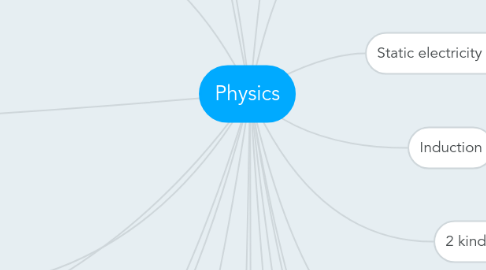Physics
da Gabriela Melendez


1. Efficiency
1.1. Is the ratio of the useful energy that comes out of the device to the total energy that went in. Percent of efficiency= E out/ E in x 100
2. Renewable resource
2.1. One that can be reused more than once (eg. Sun and wind)
3. Conductor And insulator
3.1. conductor
3.1.1. Material that allows electrons to change position (Eg. Copper wire)
3.2. insulator
3.2.1. Solid, liquid, or gas that blocks movement of electrons (Eg. Rubber)
4. Non-renewable resource
4.1. Non renewable: One that can't be replaced once it's used up (coal, Oil)
5. Potential energy
5.1. Measured by a voltmeter
5.2. Energy stored in an object
5.3. Also known as Voltage or Volt
5.4. The difference in electrical potential energy between 2 points in a circle
6. Safety device for electricity
6.1. Fuse: is a safety device that has a low melting point. If the electrical gets dangerously hot the fuse melts on to the circuit stopping the flow
6.2. Circuit breaker: Same thing as a fuse but instead of melting it has a a spring mechanism that turns off the electric flow when the wires get to hot
6.3. Three-Prong Plug: The third prong connects the device to the ground wire of the building, this sends any unwanted current flow directly to the ground
6.4. GFCI: Ground Fault Circuit Interrupter is a device that when it detects a change in current it opens the circuit which stops the current flow.
7. Static
7.1. it's an Electric charge that builds On the surface of the object
7.2. Static electricity
8. Low and high resistance
8.1. Low: Metals
8.2. High: All substances resist electrons
8.2.1. When a current resist electrons it causes it to heat up and produce light
8.3. Resistance
8.3.1. Measured in Ohms and by an Ohmmeter
8.3.2. Example: Light bulb filament
9. Short circuit
9.1. An accidental low resistance connection between 2 points In a circuit
9.2. Short circuits are dangerous because the conduction wires can be very hot
9.3. But It can be useful by allowing technicians to work on the device without interrupting the circuit
10. AC/DC
10.1. Current is measured in Amps by a device called an ammeter
10.2. Alternate current (AC) : Flows back and forth at regular intervals called cycles
10.3. Direct current(DC) : A current that flows in one direction
11. 2 kinds of circuits
11.1. series
11.2. parallel
12. Induction
12.1. Within a substance caused by a nearby charged object, without direct contact between the substance and the object and the subject
13. Generators
13.1. Transform the energy of motion into electric current, the magnets inside the generator are rotated by a turbine
14. kw*h
14.1. Means Kilowatt per hour
14.2. Measures the amount of electrical energy consumption
14.3. 1kW= 1000W
15. Calculating unknown quantity of volts, current and resistance
15.1. Known: V, I Unknown: R
15.1.1. R=V/I
15.2. Known: I Unknown: R
15.2.1. V=IR
15.3. Known: V Unknown: I
15.3.1. I=V/R
16. Static electricity rules
16.1. Opposite charges attract
16.2. Similar charges repel
16.3. Only electrons move from one object to another
17. Electrochemical cell
17.1. Made out of 2 parts, 1 electrolyte and 2 electrodes
17.1.1. Electrolyte: Is a liquid or a paste that conducts electricity because it contains chemicals that form ions
17.1.2. Electrodes: Are metal strips that react with the electrolyte
18. Law of attraction And repulsion
18.1. Law of attraction
18.1.1. Particle with opposite charge attract
18.2. Law of repulsion
18.2.1. Particles with the same charges repel
